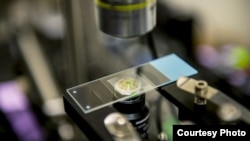Lasers aren’t normally associated with cold temperatures, but a team of researchers says it has been able to cool liquids using the focused light beams.
Writing in the Proceedings of the National Academy of Sciences, researchers from the University of Washington (UW) say they used an infrared laser to cool water by about 36 degrees Fahrenheit.
“Typically, when you go to the movies and see Star Wars laser blasters, they heat things up. This is the first example of a laser beam that will refrigerate liquids like water under everyday conditions,” said senior author Peter Pauzauskie, UW assistant professor of materials science and engineering. “It was really an open question as to whether this could be done because normally water warms when illuminated.”
The researchers said they developed their cooling laser using material found in regular, commercial lasers, but “essentially ran the laser phenomenon in reverse.”
According to the researchers, the cooling lasers may be used to “point” cool computer chips that are prone to overheating, making computers more efficient. There could also be medical applications such as cooling individual cells in order to better see how they work.
“There’s a lot of interest in how cells divide and how molecules and enzymes function, and it’s never been possible before to refrigerate them to study their properties,” said Pauzauskie, who is also a scientist at the U.S. Department of Energy’s Pacific Northwest National Laboratory in Richland, Washington. “Using laser cooling, it may be possible to prepare slow-motion movies of life in action. And the advantage is that you don’t have to cool the entire cell, which could kill it or change its behavior.”
The researchers said infrared light is better suited to biological applications because visible light can give cells “damaging sunburn.”
Still, commercial applications are likely some time off as higher powered cooling lasers with multiple crystals would be too energy intensive.
“Few people have thought about how they could use this technology to solve problems because using lasers to refrigerate liquids hasn’t been possible before,” said Pauzauskie. “We are interested in the ideas other scientists or businesses might have for how this might impact their basic research or bottom line.”
Defying Logic, Lasers Used to Refrigerate Water
- By VOA News












